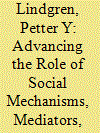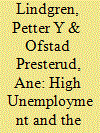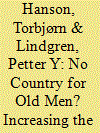|
|
|
Sort Order |
|
|
|
Items / Page
|
|
|
|
|
|
|
| Srl | Item |
| 1 |
ID:
169252


|
|
|
|
|
| Summary/Abstract |
In this article, I further develop the Copenhagen School’s securitization theory in a causal direction, by emphasizing the explanatory family of mechanisms, mediators and moderators. In the first half of this article, I present two models for conceptualizing the causal maps that securitization is part of. Next, I define five epistemological and methodological dimensions that are important for modelling securitization with causal power. The proposed approach is then put into practice by two most-similar case studies in the second half of the article: securitization attempts in Japan in 2006-07 and in 2012-15. By comparing his securitization efforts in 2006 and in 2012-15 respectively, I identify why PM Abe was successful in his securitization attempt in the latter period. Furthermore, I propose an explanatory set that together with securitization enabled certain effects to take place in Japan, namely the introduction of collective self-defense in 2014/15.
|
|
|
|
|
|
|
|
|
|
|
|
|
|
|
|
| 2 |
ID:
189405


|
|
|
|
|
| Summary/Abstract |
The SARS-CoV-2 pandemic, the subsequent non-pharmaceutical interventions by governments to reduce the transmission of the coronavirus, and adjusted consumer behaviors have resulted in high unemployment rates worldwide. In this paper, we explore whether the Norwegian Armed Forces can exploit this period of high unemployment to strengthen security and defense in Norway while increasing the job opportunities for young individuals in a difficult labor market. Before the pandemic, the Norwegian government had planned to gradually increase the number of personnel in the armed forces. Hence, an expedited recruitment strategy may improve welfare. We calculate the costs and benefits to Norwegian society of a strategy that exploits the hike in unemployment rates to recruit new personnel to the armed forces at a faster rate. We find that the expedited recruitment strategy will likely provide net benefits to society if the unemployed have a fair chance of being employed. However, we stress that there must be a real need for higher defense spending, it is difficult to estimate the economic value of defense production, and there may be a trade-off between the goals of labor market policies and those of defense policies.
|
|
|
|
|
|
|
|
|
|
|
|
|
|
|
|
| 3 |
ID:
147374


|
|
|
|
|
| Summary/Abstract |
After much deliberation, Kōmeitō, the junior partner in the second Abe Cabinet, supported the Cabinet Decision on the reinterpretation of the Japanese Constitution, which allowed for a limited version of collective self-defense. Since an expansion of the boundaries of Japanese security policy is not easily aligned with Kōmeitō’s pacifist ideals, the objective of this paper is to identify the rhetorical strategies employed by Kōmeitō in the process towards the Cabinet Decision. Through a reading of newspaper articles over a one and a half year-period, I find eight rhetorical “commonplaces”—commonsensical arguments—that the Kōmeitō leadership activated in their attempt to convince the public that Kōmeitō’s policy positions and political strategies were reasonable and to persuade the Liberal Democratic Party to rethink its position. An important finding is that most of the commonplaces Kōmeitō employed were about the form of the policy process rather than the content of the specific policies agreed upon.
|
|
|
|
|
|
|
|
|
|
|
|
|
|
|
|
| 4 |
ID:
182559


|
|
|
|
|
| Summary/Abstract |
Ageing workforces due to low fertility rates and higher life expectancies challenge modern industrialized economies. In order to secure economic welfare and to balance public budgets, governments worldwide implement reforms to increase the retirement age. The trend towards a higher retirement age confronts defense sectors that for centuries have been in search of an age structure characterized by ‘youth and vigor’. In this article, we study the economic gains to society when the special retirement age for military personnel in the Norwegian Armed Forces is increased. Combining the literatures on pension, personnel, and military economics, we identify mechanisms crucial to the outcome of a special retirement age reform. Monte Carlo simulation is applied to illustrate the potential impact on the economic net gains of uncertain variables. We find that an increase in the retirement age provides substantial net benefits to society, even under fairly negative assumptions about the consequences for retention, motivation and efforts, and the value of elderly personnel in the Norwegian Armed Forces.
|
|
|
|
|
|
|
|
|
|
|
|
|
|
|
|
|
|
|
|
|